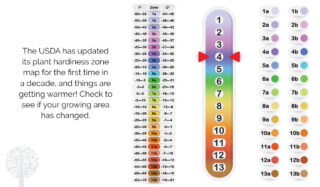USDA Updates Plant Hardiness Zones For First Time In A Decade
Everything you thought you knew about growing plants in your region may have recently changed! For the first time in a decade, the USDA has updated its ‘plant hardiness zone map’, and it looks like things are heating up. That means some growers in various parts of the world can start experimenting with different kinds of plants in the garden.
Warmer Zones
Since the 1960s, the USDA map has been a trusted guide for gardeners everywhere, helping them determine which flowers, fruits and vegetables grow best in their ‘zones.’ The map is divided into 13 zones, further divided into two half-zones. It is based on 30-year averages for the coldest wintertime temperature in a specific location. Created by the USDA and the PRISM climate group, this most recent map edition looked at temperature averages from 1991-2020.

“Overall, the 2023 map is about 2.5 degrees warmer than the 2012 map across the conterminous United States,” says the map’s lead author and PRISM director Chris Daly. “This translated into about half of the country shifting to a warmer 5-degree half zone and half remaining in the same half zone.”
With a warming climate and changing weather patterns, it is no surprise to many gardeners that their horticulture zones are changing and will continue to do so over the next several years. However, it is also important to note that the 2023 map contains data collected from new and improved weather-watching technology that didn’t exist when previous maps were created.
“The addition of many new stations and more sophisticated mapping techniques using the latest PRISM technology led to a more accurate and detailed Plant Hardiness Zone Map but also produced localized changes that are not climate-related,” Daly explains.
Check Your Zone!
To get the most out of your garden, stay updated with changes to your specific plant hardiness zone, no matter what source you follow. This will help you adjust planting dates, select seeds, and experiment with new varieties.




